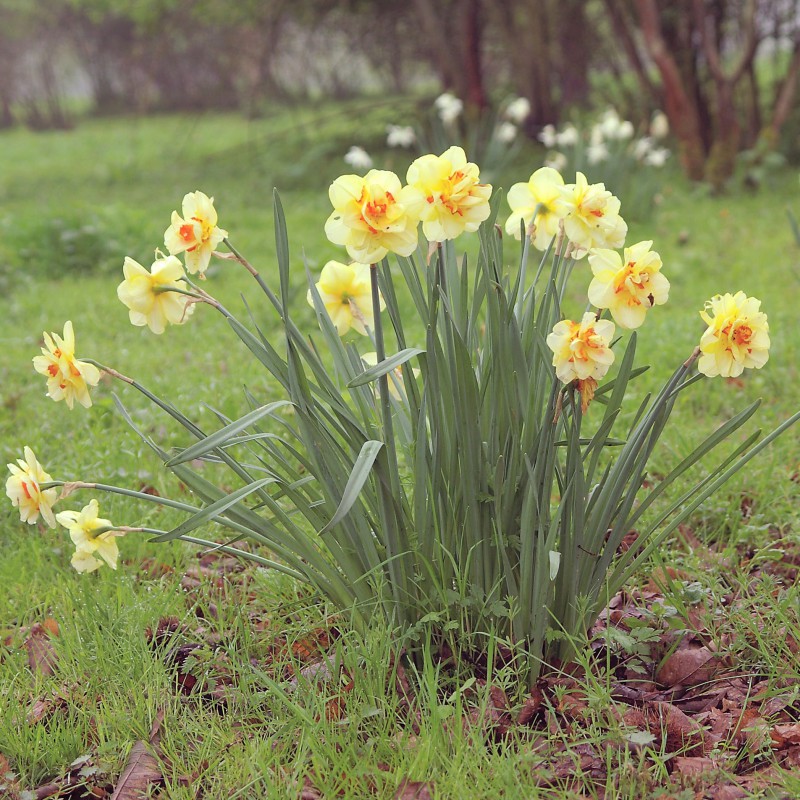By William Hrycan
Reprinted in part from the upcoming Fall 2017 edition of “The Gardener for Canadian Climates” magazine.
To me, daffodils are the sunniest, most upbeat spring flowering bulbs. Their nodding heads, with the trumpet-shaped cup surrounded by a ring of petals, seem particularly full of personality.
Daffodils are hardy, spring-blooming bulbs in the same family as amaryllis. Originally from the mountain meadows of southern Europe, they have been found in gardens all over Europe for centuries. Early North American pioneers brought daffodil bulbs with them to the New World to remind them of the gardens they left behind in Europe.
How to grow daffodils:
Plant daffodil bulbs as soon as you start seeing them in stores. This may be the end of August or early September in cooler areas, but much later in warmer areas. Daffodils need at least six weeks to root before the ground starts getting too cold. If you’ve missed this window, plant anyway (sometimes those half-price bags of bulbs at the grocery store in late October are just too hard to pass up). Your bulbs will do better in the ground than they will in storage for the winter. Just don’t hold out much hope for bulbs planted less than a few weeks before the frost starts staying in the ground.
Once planted, water-in well and don’t allow the bulbs to dry out—the bulbs prefer to be grown in moist locations. When buying daffodils, look for bulbs that are large, plump, firm and free of any signs of mold or rot.
Find a nice sunny spot, ideally one that collects lots of winter snow. I like to plant them near shrubs or behind other perennials. The daffodils will pop out of the ground early and bloom before other plants get in the way, but the foliage of nearby plants will help hide the daffodil leaves as they go dormant by mid summer.
Before planting, dig holes deep and incorporate lots of rich organic matter into soil. Plant the bulbs twice as deep as they are wide, approximately 10–15 cm (4–6 in.) to the bottom of the hole, with the pointed ends up. Space bulbs 10–15 cm (4–6 in.) apart, and plant in large groups to maximize their impact.
Daffodils don’t usually need splitting or dividing, but if you find the clumps are getting too crowded or you want to spread them around, dig up whole clumps as the foliage starts to turn yellow, carefully separate large bulbs from each other, and shake the soil off. Large bulbs connected at the base can be pulled apart and replanted, but leave smaller daughter bulbs attached to the larger mother bulb; they will separate on their own when they’re large enough.
Daffodils like moist, well drained soil. If you’re gardening in light, sandy soils, water well in the autumn as the bulbs are preparing for winter, and water during spring growth, blooming and for six weeks following blooming to keep the bulbs happy as they store energy. If you’re gardening in heavy clay, moisture may be less of a problem, but keeping soils well drained can be challenging. In either case, add plenty of organic matter to the soil to improve moisture conditions. When daffodils do not thrive, the most likely reason is soil moisture conditions. Waterlogged soil will cause bulbs to rot quickly, while dry soils will cause bulbs to whither and dry out. Both conditions are fatal, particularly to newly planted bulbs.
William Hrycan is horticultural editor for “The Gardener for Canadian Climates” magazine. A landscape architect, photographer, devoted dad and self-confessed gardening addict who gardens wherever and whenever he can. The Gardener magazine has published since 1995 and is regarded as the definitive horticultural magazine for in-depth information for our challenging Canadian growing zones.


